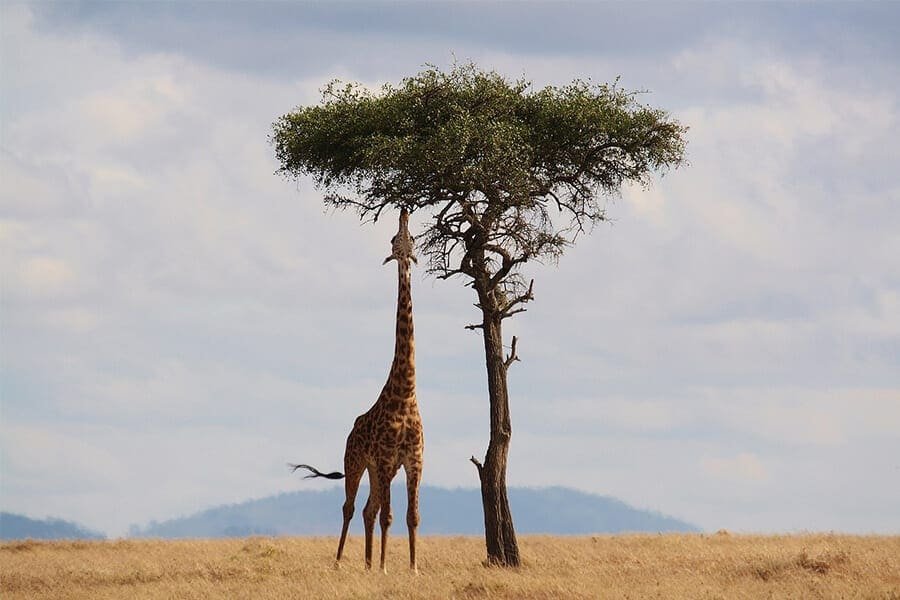Tanzania is renowned for its diverse wildlife, and among its most iconic residents are the giraffes, the tallest land animals on Earth. Animal Giraffe: With their striking height and unique coat patterns, giraffes symbolize the beauty and wonder of the African savanna. Animal Giraffe: This article explores the fascinating world of giraffes in Tanzania, delving into their biology, behavior, habitats, conservation status, and the best locations to observe them in their natural surroundings.
1. Giraffes: A Majestic Overview
1.1 The Giraffe Species
The giraffe (Giraffa camelopardalis) stands out as an African marvel, particularly the Masai giraffe (Giraffa camelopardalis tippelskirchi), known for its irregular, jagged spots. Animal Giraffe: With nine recognized subspecies, each giraffe carries unique patterns that blend with its environment.
1.2 Physical Characteristics
Giraffes are unparalleled in height, with males reaching up to 18 feet and females around 14 feet. Their long necks, supported by seven elongated vertebrae, and long legs contribute to their towering stature.
- Height: 14-18 feet
- Weight: Males up to 3,000 pounds, females around 2,600 pounds
- Coat Pattern: Unique, jagged spots for camouflage
1.3 Lifespan
Giraffes typically live 20-25 years in the wild, though they can live up to 30 years in captivity, where threats like predators and food scarcity are minimized.
2. Giraffe Behavior and Social Structure
2.1 Social Structure
Giraffes are social creatures, forming loose herds that change frequently. Herds vary in composition, sometimes consisting solely of females and calves, or bachelor groups of males.
- Female Herds: Often include other females and their young
- Male Herds: May live alone or in bachelor groups
2.2 Communication
Giraffes communicate through both vocal and non-vocal means:
- Vocalizations: Include grunts, snorts, and low-frequency sounds
- Non-Vocal Communication: Body language, such as neck swinging, conveys dominance or affection
2.3 Feeding Behavior
Giraffes primarily feed on leaves, flowers, and fruits, favoring acacia trees. Their long necks allow them to reach high into the canopy.
- Daily Intake: Up to 75 pounds of food
- Water Consumption: Giraffes can go without water for long periods, obtaining moisture from their food
2.4 Reproduction and Life Cycle
Giraffes have a 15-month gestation period, usually giving birth to a single calf. Calves are born standing, about 6 feet tall, and are nurtured by their mothers until they can eat solid food at around four months.
3. Habitat and Distribution in Tanzania
3.1 Preferred Habitat
Giraffes thrive in Tanzania’s savannas, woodlands, and open plains, particularly in areas rich with acacia trees.
- Savannas: Provide ample food and space
- Woodlands: Offer shelter and additional food sources
- Plains: Used for grazing, especially in the dry season
3.2 Distribution Across Tanzania
Key locations to see giraffes include:
- Serengeti National Park: Vast plains and scattered trees make it a giraffe haven
- Tarangire National Park: Known for its large herds of elephants and baobab trees
- Ruaha National Park: Tanzania’s largest park, ideal for secluded giraffe sightings
- Lake Manyara National Park: Diverse habitats support a healthy giraffe population
- Ngorongoro Conservation Area: Rich in wildlife, including giraffes
4. Giraffe Conservation in Tanzania
4.1 Threats to Giraffe Populations
Despite their iconic status, giraffes face significant threats:
- Habitat Loss: Due to agricultural expansion and human settlement
- Poaching: For skin, bones, and tails used in traditional medicine
- Climate Change: Affects food and water availability
4.2 Conservation Efforts
Several organizations are dedicated to giraffe conservation:
- Tanzania National Parks Authority (TANAPA): Manages parks, implementing conservation strategies
- Giraffe Conservation Foundation (GCF): Focuses on research, monitoring, and raising awareness
- Community-Based Conservation: Involves locals in wildlife management
4.3 The Role of Eco-Tourism
Eco-tourism plays a vital role in funding giraffe conservation through park fees and responsible tourism practices.
5. Giraffes in Tanzanian Culture
5.1 Symbolism and Folklore
Giraffes are deeply ingrained in Tanzanian culture, symbolizing grace and wisdom in traditional stories and art.
5.2 The Giraffe as a National Symbol
Giraffes appear in the logos of Tanzanian conservation organizations and are a key motif in promoting the country’s wildlife.
5.3 Giraffes in Modern Tanzanian Society
Today, giraffes continue to be celebrated for their beauty and their role in Tanzania’s eco-tourism industry.
6. Best Practices for Giraffe Watching in Tanzania
6.1 When to Visit
The best time to see giraffes is during the dry season (June to October), when vegetation is sparse, and animals gather near water sources.
6.2 Ethical Wildlife Viewing
Follow these guidelines for a respectful and safe wildlife experience:
- Keep a Safe Distance: Avoid stressing the animals
- Stay Quiet: Prevent startling them
- Follow Park Rules: Respect wildlife corridors and designated paths
6.3 Photography Tips
Capture stunning giraffe photos with these tips:
- Use a Telephoto Lens: To photograph from a distance
- Golden Hour Lighting: Early morning and late afternoon offer the best light
- Composition: Frame the giraffe against the sky or include its surroundings for context
7. Giraffe Conservation Success Stories
7.1 Population Recovery Efforts
Conservation strategies like habitat restoration and anti-poaching initiatives have helped stabilize giraffe populations in some areas.
7.2 Community Involvement
Local communities play a key role in conservation, benefiting from eco-tourism while protecting giraffes.
7.3 International Collaboration
Partnerships with international organizations have bolstered giraffe conservation through shared research and resources.
Conclusion
Giraffes, Tanzania’s tallest residents, are a symbol of the country’s rich wildlife heritage. By understanding their biology, behavior, and the threats they face, we can better appreciate the importance of conservation efforts. Whether you’re planning a safari in the Serengeti or exploring the woodlands of Tarangire, witnessing giraffes in their natural habitat is an unforgettable experience. As responsible tourists and wildlife enthusiasts, we can contribute to the protection of these magnificent creatures, ensuring that they continue to grace Tanzania’s landscapes for generations to come.dible ecosystems they inhabit.


